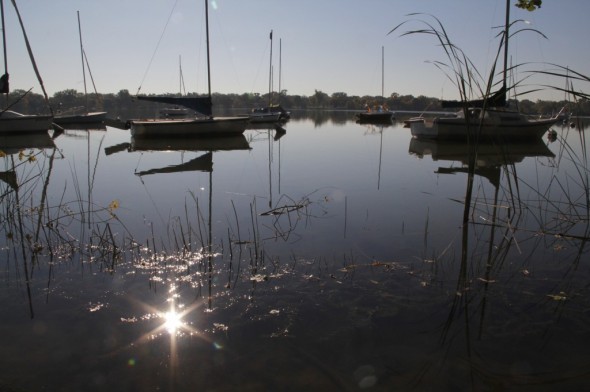Minnesota Study Scares Wisconsin
Study of lakes finds 56 chemicals that could be harmful, prompting calls for more research in Wisconsin.

Water samples from the popular Lake Nokomis in Minneapolis, shown here in October 2012, contained a component of plastic, an antibacterial soap ingredient, an antibiotic used on swine, a breakdown product of cocaine, an antidepressant, a fungicide and a drug used to treat Parkinson’s disease, according to one of two Minnesota Pollution Control Agency reports released Monday. Wisconsin’s lakes have not undergone similar scrutiny. Kate Golden/Wisconsin Center for Investigative Journalism
Water Watch Wisconsin
These stories launch a major new project, Water Watch Wisconsin. The Wisconsin Center for Investigative Journalism, Wisconsin Public Radio and Wisconsin Public Television are examining the quality and supply of Wisconsin’s water. Story ideas? Email water@wisconsinwatch.org.
Related Stories
- DNR Doesn’t Test Wisconsin Waters for Hormone-Disrupting Chemicals
- Why Experts Avoid Alarm on Hormone-Disrupting Chemicals
Links and resources on endocrine disruptors
- National Resources Defense Council fact sheet on endocrine disruptors
- e.hormone Comprehensive endocrine disruption tutorials and links from Tulane University
- Q&A for families on endocrine disruptors From the Emory University Pediatric Environmental Health Specialty Unit
- U.S. Health and Human Services Q&A about soy infant formula
- The Endocrine Disruption Exchange
- The impact of endocrine disruption: Consensus statement on the state of the science April 2013
- EPA’s Endocrine Disruptor Screening Program
Minnesota researchers found 56 chemicals — including cocaine — in the state’s waters, according to two studies released Monday that raise questions about potential impacts on wildlife and human health.
Environmental experts said the discoveries in lakes, rivers and streams increase the pressure on Wisconsin to figure out what’s in its water. A key Wisconsin Department of Natural Resources official said that the state’s waters were likely also contaminated, but that the state had no money for such monitoring.
The chemicals were detected at trace amounts in 47 of 50 Minnesota lakes, including many in relatively pristine parts of the state.
Some of the most troubling chemicals are thought to be endocrine disruptors, which can block or act like hormones in people and wildlife. They are used in pharmaceuticals, personal care products and industrial processes, but are largely unregulated.
Cocaine, to the surprise of researchers, turned up in samples from a third of the state’s lakes. Another surprisingly common find was an antibiotic approved for use only on swine.
Along with Minnesota’s past work, the studies “suggest that PPCPs (pharmaceuticals and personal care products) and endocrine active chemicals are widespread in lakes and rivers, and that fish are likely altered on genetic, cellular, organism, and population levels when exposed to the chemicals that find their way into surface water from a variety of sources,” wrote Mark Ferrey, the Pollution Control Agency researcher who conducted the two studies.
Former Wisconsin DNR secretary George Meyer said the tests show that Wisconsin, which has not conducted similar studies on this scale, needs to develop a plan to figure out what’s in its water.
“It’s the old adage ‘If you don’t look, there’s not a problem,’ right?” said Meyer, now the executive director of the Wisconsin Wildlife Federation, a sportsmen’s conservation group. “The public needs to know what’s in the water and what the significance of that is.”
Meyer said it was highly likely that Wisconsin’s lakes would show a similar chemical profile to Minnesota’s — and might show, he added, “possibly even a higher level of chemicals.”
“I think we should thank Minnesota for bringing some light to this issue,” said Melissa Malott, water program director of Clean Wisconsin, an environmental advocacy group. “It doesn’t in any way change my opinion that we should be doing something about this in Wisconsin.”
Minnesota has one of the nation’s most ambitious state-level testing programs for unregulated contaminants in surface waters.
The Minnesota agency’s statement did not speculate on potential human effects, which were beyond the scope of the study.
Experts say fish are more vulnerable to surface water pollution than people because they live in water, so they get more exposure. Previous Minnesota studies have documented endocrine disruption in fish from the Mississippi River and other contaminated waters.
But the chemicals are of growing concern to people, too: A United Nations report in February noted the rise in endocrine-related disorders like cancer, obesity, early puberty and infertility and identified widespread pollution as a “global threat” to wildlife and people.
Science on chemicals’ presence in the environment has exploded since a landmark 2002 U.S. Geological Survey study found them widespread in streams and groundwater susceptible to contamination.
But much of the science so far has focused on waters assumed to be polluted, like those receiving wastewater treatment plant effluent, while the waters in the two new Minnesota studies were chosen randomly. The studies also were unusual for the large number of samples, which can produce more statistically robust results.
“This study shows these compounds are out there, and that gives more supporting evidence that you should do these studies in other states,” said Dana Kolpin, the USGS scientist who led the 2002 study. “It wouldn’t be a waste of taxpayer dollars.”
Questions remained, Kolpin said, about how septic systems, recreational water use, wastewater treatment plants and other sources each contributed to contamination.
Ferrey agreed and said that was the next step.
“Will we see correlations between land use and the appearance of the chemicals that we detected in these lakes or rivers?” Ferrey said. “We just haven’t done that kind of analysis yet.”
(The story continues on page 2)
Article Continues - Pages: 1 2
-
Legislators Agree on Postpartum Medicaid Expansion
 Jan 22nd, 2025 by Hallie Claflin
Jan 22nd, 2025 by Hallie Claflin
-
Inferior Care Feared As Counties Privatize Nursing Homes
 Dec 15th, 2024 by Addie Costello
Dec 15th, 2024 by Addie Costello
-
Wisconsin Lacks Clear System for Tracking Police Caught Lying
 May 9th, 2024 by Jacob Resneck
May 9th, 2024 by Jacob Resneck






















It would be interesting to see not only what chemicals are in Wisconsin bodies of water, but also what is in the water that comes out of our taps. Water purification plants don’t take any of theses chemicals out.
Hopefully, this is something that UW-Milwaukees new water institute could analyze…
@Bob We should have a bit more on that next week.